|
简述:“乐龄农庄“是一个为未来城市的下一代养老住宅提供解决方案的概念性项目:它向新加坡及其他国家或地区展示了一个将老年公寓、生活设施与垂直农场相结合的宜居方式和农业技术---乐龄人士将生活在一个由蔬菜农场建立的高密度花园内,在那里甚至还可能为他们带来就业机会。虽然这是两个独立的领域,但是一旦结合,就会被激发出无限潜能,这也正是SPARK思邦所关注的。同时,在进行这项研究型设计时,SPARK思邦发现新加坡正面临着两项紧迫的挑战:这个国家如何应对和维持一个迅速老龄化社会的稳定;他又将如何加强食品安全问题等(因为新加坡90%的食品目前依靠进口才能实现)。
| |
首层效果图 © SPARK
| 为了解决亚洲地区的人口老龄化和粮食短缺问题, SPARK推出了一个为未来城市的下一代养老住宅提供解决方案的概念性项目。 该提案题为“乐龄农庄”,生活设施与垂直农场相结合的宜居方式和农业技术---乐龄人士将生活在一个由蔬菜农场建立的高密度花园内,在那里甚至还可能为他们带来就业机会他们还可以找到工作。
“我们为新加坡设计了这个概念,”SPARK负责人Stephen Pimbley如是说,“在任何地方实施这个项目都是有可能的,建筑的立面和屋顶都可用来种植绿叶植物。”他继续说,“我们渴望在未来的某一天看到这个项目得以实现。 这个概念可以解决全球发展中城市面临的诸多迫切需要解决的问题。”
请继续阅读,以了解更多关于这个概念。
To address issues surrounding Asia’s aging population and food scarcity, SPARK has unveiled a conceptual project the blends affordable retirement housing with urban farming. The proposal, titled “Home Farm,” integrates vertical aquaponic farming and rooftop soil planting with high-density housing designed for seniors that provides residents with a desirable garden environment and opportunities for post-retirement employment.
“We designed this concept for Singapore,” says SPARK Director Stephen Pimbley, “but there is the potential for it to be applied in any location that would support the growth of leafy green vegetables on building facades and rooftops.” He continues, “We are keen to see this project materialise at some point in the future. The concept is a realizable solution to real and pressing problems faced by many of the world’s growing cities.”
Read on to learn more about the concept.
| |
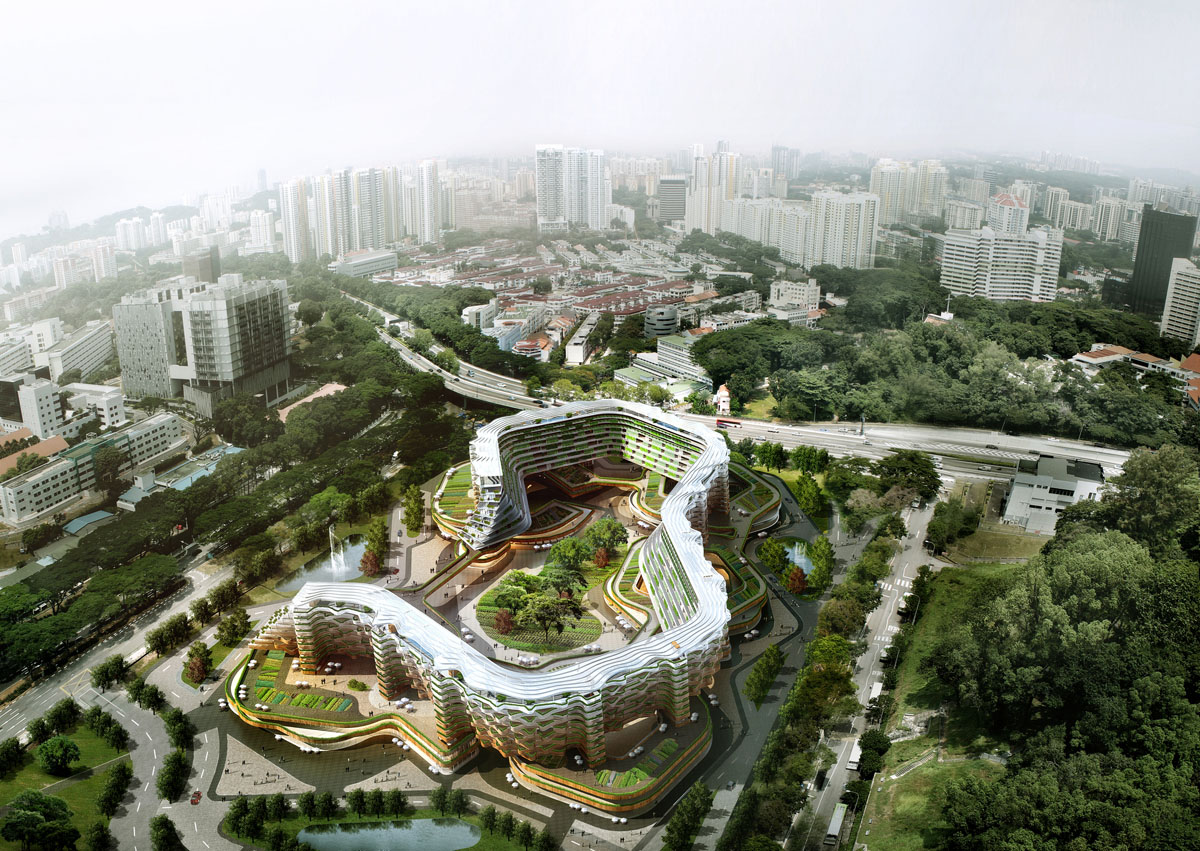
© SPARK |
人口老龄化的问题
在亚洲人口迅速老龄化这一进程正在发生,西方超过50年才走完的这一过程在亚洲被压缩到20年到30年。在亚洲,65岁及以上的人数预计会从2000年的2.07亿人增长到2050年的8.57亿人,这一增长率高达314%。
新加坡也不例外。新加坡的人口平均年龄已经从1980年的24.4岁上升到2013年的38.9岁。预计寿命也从1980年的72.1岁跃升到2013年的82.5岁。新加坡的平均年龄将持续增长,并且年龄分布也发生了显著转变。在1970年,只有3.4%的常住人口年龄在65岁及以上。但是在2012-2013年这一数据都超过了10%,到了2014年这一数据达到11.2%。新加坡的养老保障也从1970年的13.5:1(20~64岁的人/老年人)急剧下降到4.8:1左右,预计2030年的时候,这一比例将会进一步下降到2:1。
From the architect: The Problem with Aging
The aging process is occurring rapidly in Asia. Changes that occurred over 50 years in the West are being compressed into 20 to 30 years in Asia. The number of people aged 65 and above in Asia is expected to grow by 314% from 207 million in 2000 to 857 million in 2050.
Singapore is no exception. Singapore’s median age has risen from 24.4 years in 1980 to 38.9 years in 2013. Life expectancy has jumped from 72.1 years in 1980 to 82.5 years in 2013. The median age is projected to keep increasing. Singapore’s age distribution is shifting significantly. In 1970, just 3.4% of the resident population was aged 65 and over. The proportion crossed the 10% mark during 2012-2013, and in 2014 it is 11.2%. Singapore’s old-age support ratio has dropped dramatically from 13.5:1 (20-64 year-olds per senior) in 1970 to around 4.8:1, and by 2030 the ratio is predicted to decline further to 2:1.
| |
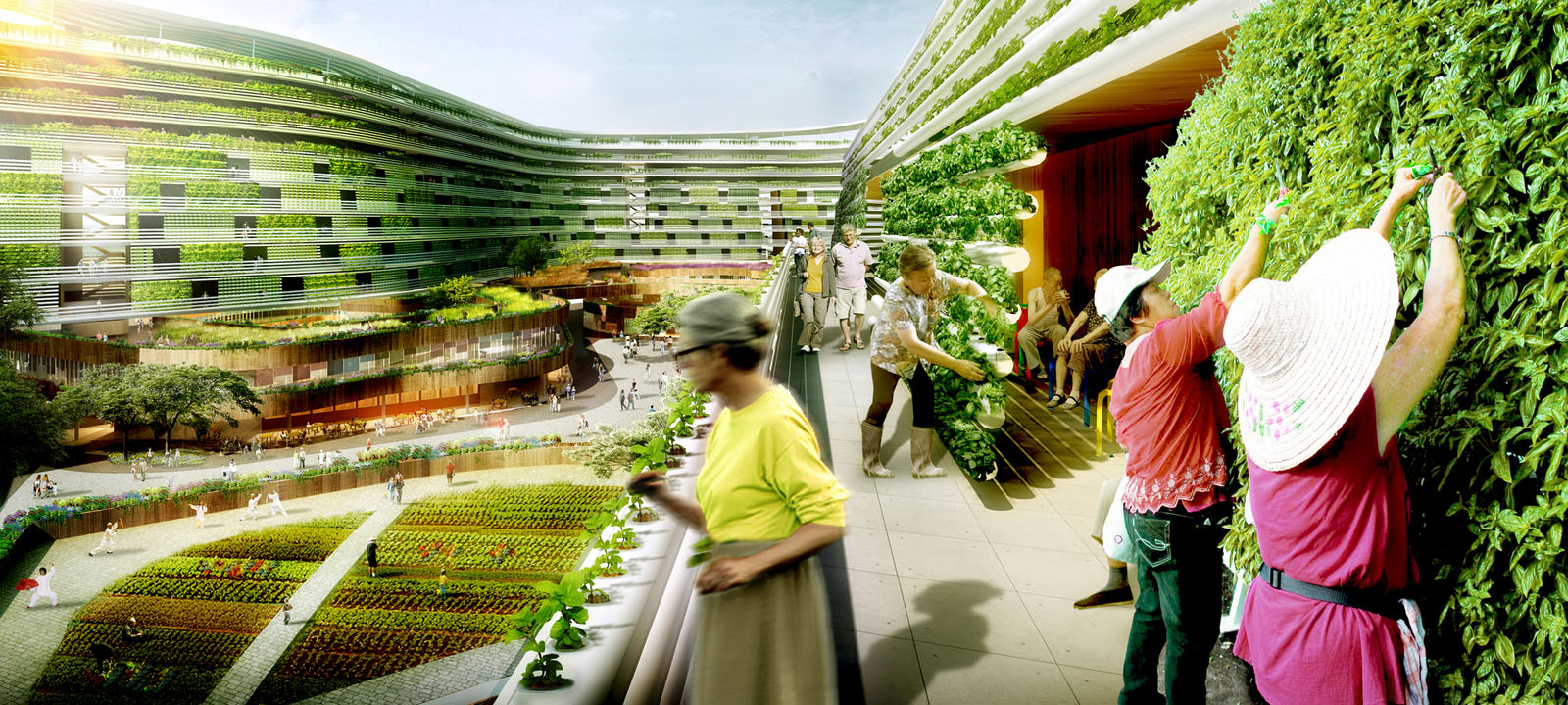
四层效果图 © SPARK |
粮食安全问题
新加坡是仅有的七个完全城市化的地方之一—一个完全没有内陆城市的国家。 在20世纪60年代,20000个农场仍然占据约新加坡的国土面积的四分之一,其用来生产蔬菜、水果、橡胶、烟草、香料和兰花,饲养猪和家禽。 农民可以自给自足建造基础设施项目、房屋和工业设施。
目前新加坡进口的粮食超过90%。 新加坡的小型农业部门主要生产鸡蛋、鱼、家禽和蔬菜。 生产的观赏鱼和兰花用于出口。 新加坡高度依赖进口食品使得粮食安全成为非常突出的问题。
新加坡政府的农业食品和兽医局(AVA)已为食品来源多样化制定策略,(由于缺乏传统的农田空间)并通过密集型的农业技术提高本地生产叶菜类蔬菜、鱼和蛋的能力。
The Problem with Food Security
Singapore is one of just seven fully urbanized places – a city state without a hinterland. In the 1960s, 20,000 farms still occupied about a quarter of Singapore’s land area and produced vegetables, fruits, rubber, tobacco, spices and orchids. Pigs and poultry were reared. Farmers have since made way for infrastructure projects, housing and industry.
Currently Singapore imports over 90% of its food. Singapore’s small agricultural sector produces primarily eggs, fish, poultry and vegetables. Ornamental fish and orchids are produced for export. Singapore’s high dependency on food imports makes food security a very prominent issue.
The Singapore Government’s Agri-food and Veterinary Authority (AVA) has in place strategies for the diversification of food sources and (given the lack of space for traditional farmland) the boosting of the local production of leafy vegetables, fish and eggs through intensive agricultural technology.
| |
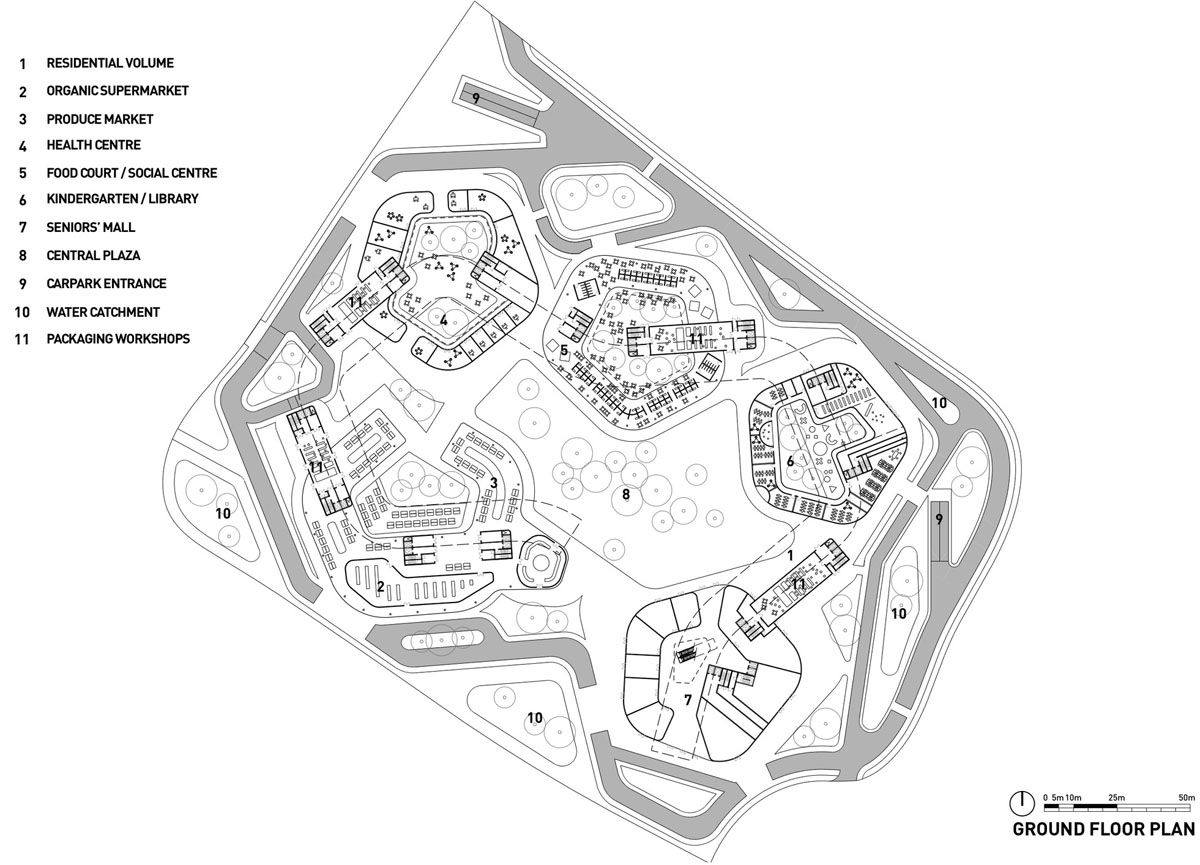
首层平面图 © SPARK
剖面图 © SPARK |
新加坡老年人的生存现状
新加坡最常见的仍然是老年人与他们的配偶和独生子女生活在一起。 然而,非传统的生活方式有明显增加的趋势(第二最常见的生活方式)。 独自生活是第三最常见的生活方式。
调查显示,新加坡的老年人需要更多的钱。 许多老年人收到来自子女的现金资助。 然而,他们的收入来源正在转变,越来越少的人从他们的孩子那里获得钱,基于需求及法律,更多老年人则自己工作挣钱。 超过四分之一的新加坡老人遇到一定程度的财政不足。
慢性病在新加坡的老年人中间是常见的。 报告称年龄55岁以上老年人最常见的病是高血压和胆固醇、糖尿病和关节炎。门诊治疗是最常见的。
The Living Situation of Singapore’s Seniors
It remains common for older people to live with their spouse and children only. However, there is a marked increasing trend for non-traditional living arrangements (the second-most common arrangement). Living alone is third-most common arrangement.
Surveys reveal that Singapore’s seniors need more money. Many receive cash support from their children. The income sources of Singapore’s seniors are shifting, however. Fewer are taking cash from their children, and more are working – by need and by law. Slightly more than one in four of Singapore’s seniors encounter some degree of financial inadequacy.
Chronic diseases are common among older Singaporeans, but they are fit and mobile. The most common medical conditions reported by seniors aged 55+ are high blood pressure and cholesterol, diabetes and arthritis. Outpatient treatment is common.
| |
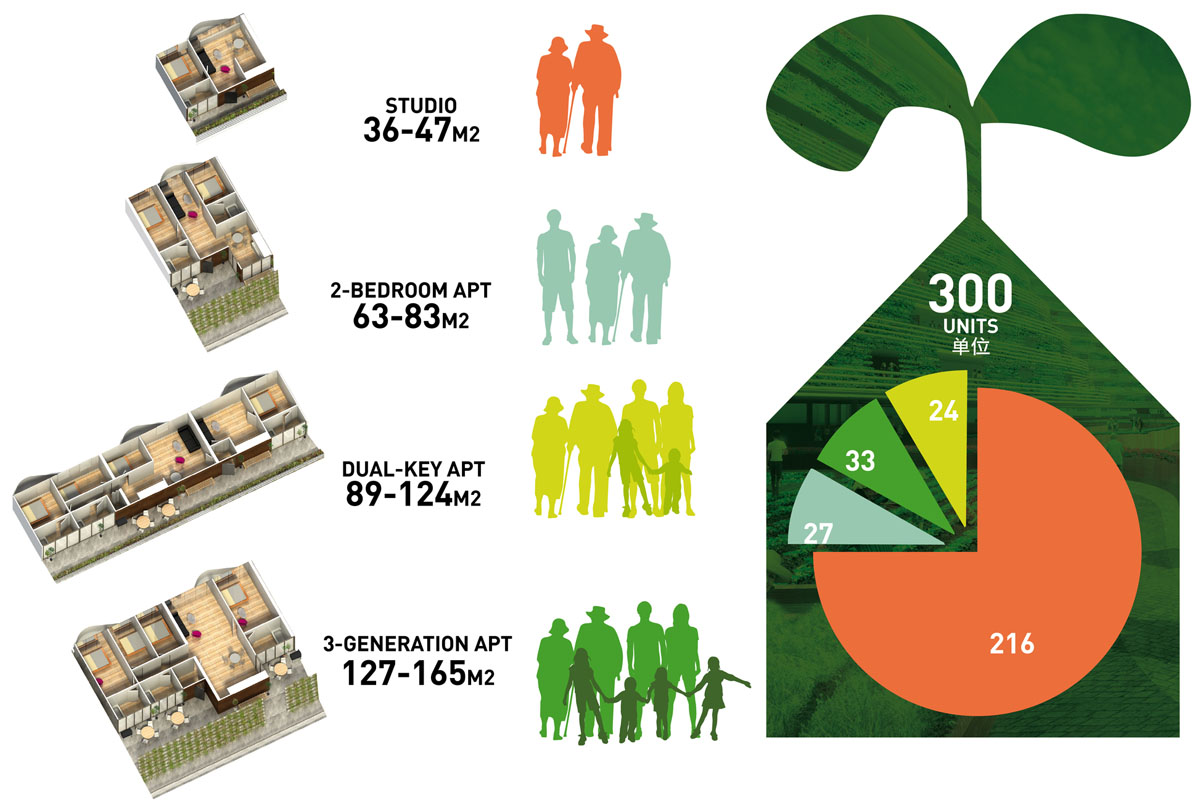
混合公寓 © SPARK |
新加坡政府对人口老龄化的战略
成立于2007年的新加坡老龄工作委员会(MCA),旨在协调政府应对人口老龄化。 “成功老龄化”是其愿景,通过提高老年人的参与、健康和安全来实现。 其四个关键点是:
1. 加强就业和经济保障
2. 建设老龄设施(建立无障碍设施和基本服务的社区)
3. 提供全面且可负担的卫生保健和老年护理
4. 促进积极的老龄化(保持身心健康,并继续奉献社会)
The Singapore Government’s Strategy for an Aging Population
Singapore’s Ministerial Committee on Aging (MCA) was established in 2007 to coordinate the Government’s response to an aging population. It has a vision of “Successful Aging,” to be achieved through the enhancement of participation, health and security for seniors. Its four key thrusts are:
1. Enhance employment and financial security
2. Enable aging-in-place (with a barrier-free environment and essential services in the community)
3. Provide holistic and affordable healthcare and eldercare
4. Promote active aging (to maintain physical and mental wellbeing and continue contributing to society)
| |
生产能力 © SPARK
|
家庭农场模式
家庭农场是一个简单的水培系统,现已成功应用于新加坡屋顶种植。 在家庭农场,鱼菜共生已经应用在建筑外墙。 线性种植的土壤栽培农业应用于建筑高层及公共设施建筑。
老年人在家庭农场的工作可能包括种植、收割、分拣、包装、旅游、现场销售、递送、清洁等等。 家庭农场的居民工人的薪酬可能包括:支付工资,抵销租金或水电费,抵消门诊医疗保健费,或免费的产品。
家庭农场被设计为私人机构而非公共机构,而且是一个遭受财务压力的老人能够负担的地方。 该架构被设想为利用简单的材料和零部件来实现模块化经济建设。 这个概念提供了多方面的好处,包括经济、粮食安全和质量、社会参与、健康、可持续发展、创造空间和医疗保健等。
The Home Farm Model
Home Farm adapts a simple aquaponic system inspired by that which has been successfully used in Singapore by rooftop farming initiative ComCrop using off-the-shelf components. At Home Farm, aquaponics have been adapted for use on the building façade. Soil-based farming is proposed for linear planting beds at the highest levels, as well as the rooftops of facilities buildings.
Jobs for seniors at Home Farm could include planting, harvesting, sorting, packing, tours, sales on site, delivery, cleaning, and so on. Possibilities for the remuneration of Home Farm’s resident workers could include: payment of salary, offsetting rental or utilities bills, offsetting healthcare costs at the on-site clinic, or free produce.
Home Farm is imagined as a private rather than public entity, but one that is within the reach of seniors who encounter financial stress. The architecture has been conceived for economic construction using simple materials and modular parts. The concept offers multi-dimensional benefits related to economics, food security and quality, social engagement, health, sustainability, place making, and healthcare provision.
| |
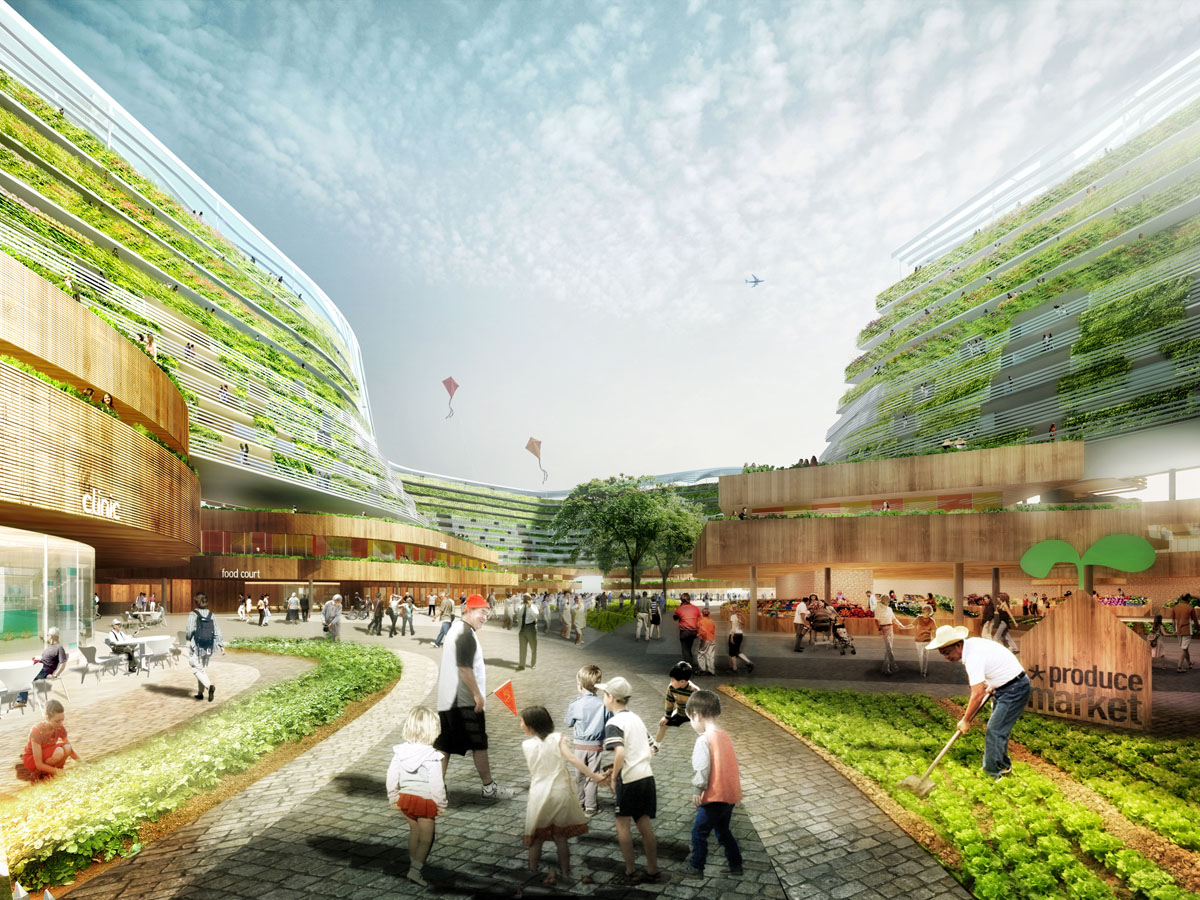
入口© SPARK
总平面图© SPARK
三层平面图© SPARK
七层平面图© SPARK
九层平面图© SPARK
生物废料锅炉© SPARK
水循环© SPARK |
关于SPARK思邦:
SPARK思邦是一家屡获殊荣的国际建筑设计咨询公司,在建筑、城市、景观建筑以及室内设计领域拥有丰富的经验,其创造出的独特项目横跨亚洲、欧洲和中东。SPARK思邦拥有一个充满活力的团队,由覆盖16 个国家、横跨3 大洲的100 多名员工组成,将国际与本地人才的最佳经验相结合。
基于要创造出务实的、社会化的以及令人愉悦的建筑的理念,SPARK思邦与客户紧密合作,创作出以财务可行性为基础、提高生活质量为目标的可持续建筑。
SPARK思邦的办公室分布在北京、伦敦、上海和新加坡。获奖项目包括新加坡克拉码头、上海国际港客运中心(2011年度MIPIM亚洲大奖,“最佳综合体开发”大奖)、吉隆坡升喜廊购物中心,以及宁波和北京的来福士广场项目。
| |
| | 建筑事务所:Spark Architects
地点:新加坡
项目负责人:Stephen Pimbley
设计团队:Yun Wai Wing, Wenhui Lim, Chanachai Panichpattan, Ethan Hwang, Jay Panelo, Narelle Yabuka
年份:0
摄影:SPARK
| Architects : Spark Architects
Location: Singapore
Project Director: Stephen Pimbley
Design Team: Yun Wai Wing, Wenhui Lim, Chanachai Panichpattan, Ethan Hwang, Jay Panelo, Narelle Yabuka
Year: 0
Photographs: SPARK
| |
| 出处:本文译自www.archdaily.com/,转载请注明出处。
编辑:许航,卢荣姝
| |
|
|
